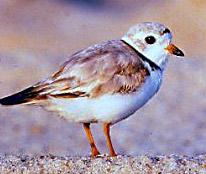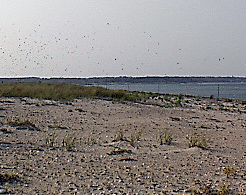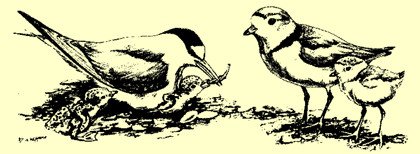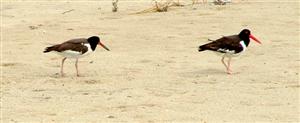Nesting Shorebirds

Piping Plovers
The Atlantic Coast population of piping plovers were listed as "Threatened" under the Federal Endangered Species Act in 1986, which means that this population is in danger of becoming Endangered. In 1986 there were only 139 pairs on Massachusetts beaches and 790 breeding pairs for the entire Atlantic Coast, from Atlantic Canada to South Carolina. With this protection, the Atlantic Coast population has increased to 511 pairs in Massachusetts and 1,676 pairs for the entire coast (2003 data).
Their nest is a slight depression in the sand, generally away from beach vegetation. Their nests are very hard to find since the patterns on the eggs resemble sand and stones. The adults will silently leave their nest and eggs when beach users approach too closely, so it is easy to inadvertently disturb these birds. Repeated or prolonged disturbance can lead to nest abandonment.
There are two major reasons for the observed population increases since 1986. One management tool we use is putting up fencing around nests to keep predators (primarily American crows, striped skunks and gulls) away while still allowing the plovers to freely come and go. These are called predator exclosures. A second management tool we use is symbolic fencing - rope strung between posts - to keep beach users a safe distance from the nests.
Piping plovers leave the Vineyard in August or September to spend their winters along the U. S. Atlantic and Gulf Coasts from the Carolinas to Florida and Texas.
Least Terns
Least terns are listed as a "Species of Special Concern" under the Massachusetts Endangered Species Law. Since 1985, their population has varied from a low of approximately 2,000 breeding pairs in 1987 to a high of approximately 3,400 pairs in 2001. By 2003 the population had declined back to approximately 2,500 pairs.
This species nests in colonies ranging from 5 pairs up to the large colony of 520 breeding pairs pictured at right from Joseph Sylvia State Beach in 2002. When nesting they are quite brazen, and will divebomb anyone who ventures to close to the colony.
Least tern colonies are not necessarily in the same place year after year. Each of the County managed beaches (Norton Point Beach, Eastville Point Beach and Joseph Sylvia State Beach) has good nesting habitat even though it is not occupied every year. Based on our observations, a colony site is more likely to become abandoned if predators are active within the colony. For example, the nests of the 520 breeding pairs of terns on State Beach in 2002 were wiped out by great black-backed gulls and skunks (within one week of taking the above photo). This site, in the middle of the Oak Bluffs side of the beach, was not used in either 2003 or 2004.
Restricted Area: YOU CAN HELP PROTECT THESE SPECIES
American Oystercatchers
- More information on piping plovers is on the U.S. Fish and Wildlife Service website.
- Here is a link to the most recent (1996) Atlantic Coast Piping Plover Recovery Plan
- For a current list of State Listed Species
- For a current list of all Federal Listed Species or just those found in Massachusetts



